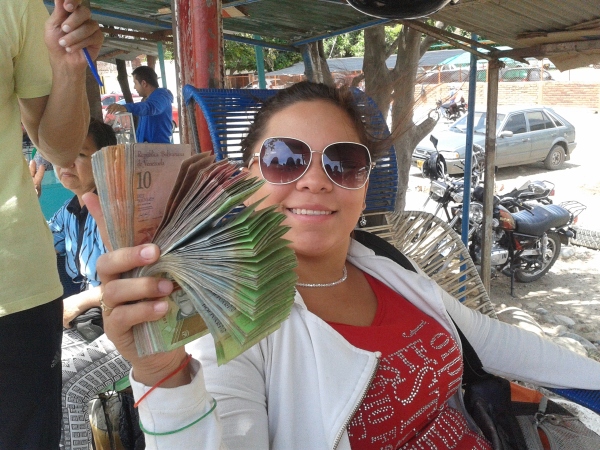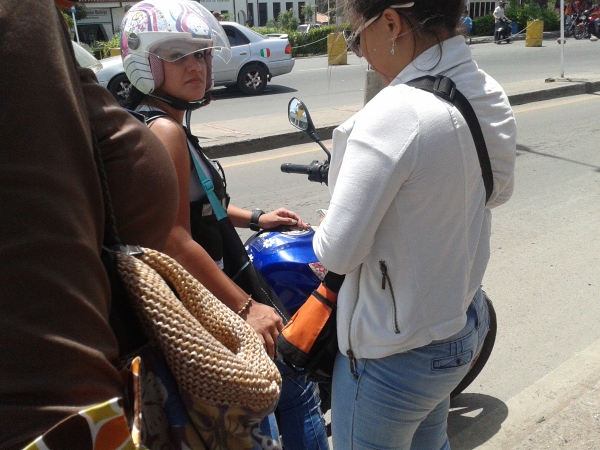Angie is a young Colombian woman scarcely 26 years old. Every day she sets up her stall in a place called “La Parada”,1 Cúcuta, a few metres from the Simón Bolivar International Bridge and under the noses of Colombian customs.
We found her smiling despite the heat in the area. Of course, she fans herself with a wad of Venezuelan notes...
In context...
In San Antonio del Táchira2 it is almost “Mission Impossible” to find businesses that use “points of sale” to pay with a credit or debit card. We could confirm during our stay in that city, as part of field work about Border Journalism, with students of Social Communication from the Bolivarian University of Venezuela.
It was difficult to find any restaurant with this method of payment and after a lot of searching we found that only the fast food places have “EFTPOS”. In the rest, all over the place you read: “There's no EFTPOS. Only cash”. The reason?: our notes of 100 and 50 Bolivars (Bs) are really coveted to be traded in an illegal manner and to obtain juicy profits. A practice that has been perfected, and that in the first instance was common among Colombian citizens (I haven't lost my capacity to be amazed by their creativity), but that now, lamentably, it has generalised itself among Venezuelans also, that is to say, everybody is in that game. The important thing is to make easy money, without working too much and to do so safely and quickly. The other thing is that the notes manage to pass to the other side and in great quantities...
The question is why the National Banking Association or the Central Bank of Venezuelan doesn't intervene? Each time that we had to pay in cash for some food, the owner of the business would be making calculations of the profits that they expected from it. With each Bs. 100 note that they saw their eyes sparkled, like the gold tooth of Pedro Navaja.3
In that border crossing the Venezuelan banknotes serve to: 1) be sold in currency exchange offices in Cúcuta. The profit in bolivars is fast and they deposit it directly in your bank account. If it's with Banesco even better; 2) be sold by “pirate” money changers to Colombians that need to buy subsidised Venezuelan products. They sell them cheaper than the “legal” currency exchange offices that by the way fix their rates according to the guide of the Dólar Today4 website; 3) be exchanged in Colombia for Colombian pesos that later re-enter Venezuela to buy bolivars.
I live off your bolívar…
The phrase makes me shudder. I asked her permission to take the photo and she posed smiling. And I have to ask her..
What does your business consist of?
– The business is that I sell bolivars. On very good days I can sell up to one thousand bolivars and with that I can myself up to seven thousand pesos. During the week the profit is very good and sometimes take away some 60 thousand or 70 thousand pesos in the week.
A what rate do you sell them?
- It depends on how it is below (in Cúcuta) and on how we receive it, and bit by bit the profit is left over. On the weekends and at the ends of the month the bolivar goes up more because few currency exchange offices open and then we earn a little bit more.
And that is legal? I say the Colombian police are right there. They don't put you in jail?
– Legal, it isn't, of course, but they leave us alone and we always give something to them...
If you take away 60 thousand pesos a week, then a month...?
– Like 500 thousand pesos...This is my job, I live from this.
How do the notes arrive to you?
(…) She holds back a sly smile and doesn't respond…
Then that [idea] that the bolivar isn't worth anything? For you, it's worth something, isn't it?
– I live off your bolivar…
The interview is suspended because a Colombian lady arrives on a motorbike to buy bolivars. She has a boy behind her on the back of the bike. She wears a helmet, but he doesn't. She gives me a dirty look when I take her photo while Angie sells her the notes.
What are you buying notes for?, I ask her
– The thing is that I am going to the hairdresser, it works out cheaper in San Antonio...
How much is it going to buy?
– I need 600 bolivars. Don't take photos of me.
And why don't you buy them in a money exchange offices?
– Ah the thing is that she is my friend…
In two minutes, Angie earns herself 600 pesos. We can't keep talking because more customers arrived. Before that she told me that she studied Pharmaceutical Service and that selling bolivars not only pays for her studies, but that it helps her family.
The lines at the cash machines
The worst idea that occurred to the students, Ana Purroy and Héctor Serrano, was to take out cash from an automatic teller machine there in San Antonio of Táchira. They both located one from the Bank of Venezuela and they had to wait at least two hours in the line. From that experience Ana constructed the following account that closes (for now) the series of reports from the hottest border in Latin America:
“In plaza Bolívar de Cordero, in San Antonio del Táchira, you live daily a totally irregular situation due to long lines to get cash out of the automatic teller machines (ATMs). According to neighbours of the place, sometimes you can take up to six hours to make a transaction due to the tremendous demand for Venezuelan banknotes. We had to beg that they might let us take out some cash.
You deal with one of the modus operandi for the extraction of the Venezuelan currency to Colombia. Our currency is exchanged for pesos in Cúcuta and returns to San Antonio again to buy bolivars. The exchange is strange but is due to the fact that for every thousand pesos exchanged in Venezuela the percentage of profit is between 25 to 30%.
The practice in the ATMs is done in the following manner: from a personal account you can make up to three transactions and take out each time up to 600 Bs. Two of banks (Venezuela and Banesco) allow you to get out 20 thousand BS, but as it doesn't give it all at one time you have to put in your cards many times. One person goes to the ATM with more than one card from different banks and like that you can take out three times with each one. The other business is that there are people that offer to wait in the queue for you and they pay them 600 Bs per card, that is to say, if you have six cards from six different banks, they earn up to 3,600 Bs.5 There are people that live from that, from waiting in the line at ATMs in San Antonio del Táchira..
This was a practise that only Colombians used to carry out, but now Venezuelans have adopted it also and we wonder if the proper Venezuelan authorities are aware of this illegal procedure given that while we were in the line we noticed the presence of the Bolivarian National Guard (GNB) near the ATM, but they never intervened despite the fact that the irregularity was obvious.”
1“The
Stop”
2 San Antonio del Táchira is a Venezuela city on the border with Colombia. A highway from San Cristóbal, the capital of state of Táchira, to Cúcuta, Colombia passes through the city and makes it an important transit point between the two countries.


